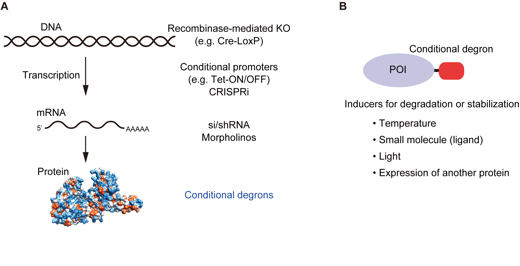Conditional Degrons for Controlling Protein Expression at the Protein Level
Division of Molecular Cell Engineering / Kanemaki Group
Conditional Degrons for Controlling Protein Expression at the Protein Level
Toyoaki Natsume and Masato T. Kanemaki
Annual Review of Genetics, DOI:https://doi.org/10.1146/annurev-genet-120116-024656
It is a common genetic analysis in many organisms to see the phenotype after depletion of a protein of interest. Technologies such as siRNA and conditional gene knockout have been employed for this purpose. However, these do not deplete a protein of interest directly. It is, therefore, the depletion effect is indirect and it takes for a relatively long time to deplete a protein of interest, depending on the half-life of the protein. This sometime causes a problem because the phenotype can be complicated by a secondary effect that was initiated by a primary defect.
Recently, conditional degron technologies, by which a degron-fused protein can be induced for rapid degradation, are seizing the attention. Protein depletion by the degron technologies work directly at the protein level, so that it is possible to analyze the direct effect after rapid protein depletion. We developed the auxin-inducible degron technology by which a degron-fused protein can be controlled by a plant hormone auxin. Others used temperature, small chemicals, light, or the expression of another protein for the similar purpose. We wrote a review paper explaining the development history of conditional degrons and their characteristics.

(A) Conditional technologies for controlling protein expression. From the level of gene to protein, various technologies have been developed. Conditional degrons work at the protein level. (B) Conditional degrons can be controlled by temperature, small chemicals, light, or the expression of another protein.















